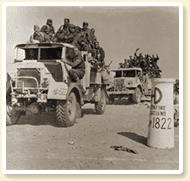

Truck-carried British infantry crosses the border of Tunisia. |
The North African Campaigns, 1940-1943
A significant part of the Second World War was fought in North
Africa. British, Canadian, Commonwealth, American and French forces
confronted the Italian-German Axis across the desert sweep of
northern Egypt and Libya and in the more hilly coastal areas of
Morocco, Algeria and Tunisia
In September 1940, Italian leader Benito Mussolini wanted to enlarge
his Italian empire in Africa, which already included Libya and
Ethiopia, by invading Egypt, then part of the British Empire. The
Italians were driven back into Libya until Germany, eager to extend
Axis influence into the Middle East, sent a force to Mussolini's
side. After a series of advances and retreats, by late 1942 the
British were able to gain air and sea superiority in the
Mediterranean, which enabled their armies to push the Germans and
Italians west through Libya.
North Africa was one of the few theatres in which the western could engage the armies in order to relieve
pressure on the Soviet Union, which had joined the Allied side in
June 1941 and had been invaded by the Germans. On November 8, 1942,
American and British troops landed in Morocco and Algeria,
controlled by Hitler's puppet, the French government at . The French soon
agreed to a ceasefire with the , but German troops
poured into French Tunisia. Although the Germans succeeded at first
against their as yet inexperienced foe, by the spring of 1943 the
united Allied forces from Algeria in the west and Libya in the east
pushed the Germans and remaining Italians into the north-east coast
of Tunisia. A few soldiers escaped, but some 275,000 became prisoners
of war of the .
No. 417 , RCAF, flew fighters above the armies from Egypt to
Tunisia. Canadian-manned landing craft supported the Algerian and
Moroccan landings, as did sixteen corvettes. The corvettes
sank three submarines in the North African , but HMCS Louisburg
and Weyburn were lost.
Related Newspaper Articles
English Articles
French Articles
-
Les Allemands en Afrique du Nord
Le Devoir, 02/10/1940
-
"Les troupes anglaises continuent d'avancer, de faire des prisonniers et d'amasser du butin"
Le Devoir, 13/12/1940
-
Les troupes canadiennes et l'Égypte
Le Devoir, 12/23/1940
-
Libye. Les Anglais commencent à attaquer Tobrouk
Le Devoir, 04/01/1941
-
"En Afrique. Les troupes britanniques prennent Bengasi, dernière place forte italienne en Libye orientale"
Le Devoir, 07/02/1941
-
"Libye. Contre-offensive de l'armé Rommel "
Le Devoir, 26/01/1942
-
Libye. Bengasi tombe aux mains de l'ennemi
Le Devoir, 30/01/1942
-
Libye. L'armée anglaise abandonne Derna et retraite de 50 milles en deux jours
Le Devoir, 30/01/1942
-
"En Libye, une bataille est engagée au sud de Bir-Hacheim"
Le Devoir, 27/05/1942
-
Libye. Les divisions de Rommel encerclent Tobrouk
Le Devoir, 18/06/1942
-
Libye. Après la prise de Tobrouk
Le Devoir, 22/06/1942
-
Renforts à l'armée anglaise de Libye
Le Devoir, 23/06/1942
-
Egypte. Les position défensive d'El Alamein tiennent ferme
Le Devoir, 03/07/1942
-
Egypte. Bombardement de Tobrouk
Le Devoir, 18/07/1942
-
La bataille est acharnée en Tunisie
Le Devoir, 07/01/1943
-
La poursuite contre Rommel continue
Le Devoir, 21/01/1943
-
Tripoli tombe aux mains de l'armée de Montgomery
Le Devoir, 23/01/1943
-
Toute l'armée de Rommel a retraité en Tunisie
Le Devoir, 25/01/1943
-
Tunis et Bizerte tombés aux mains des armées américaines et anglaises
Le Devoir, 08/05/1943
-
Les Alliés sont définitivement maîtres de l'Afrique
Le Devoir, 13/05/1943
|